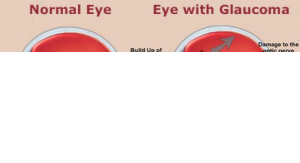According to the World Health Organization(WHO), Glaucoma is the second leading cause of blindness worldwide behind cataract and the number one cause of irreversible blindness globally. There is an estimated 4.5 million persons globally are blind as a result of it and that figure will rise to 11.2 million by the year 2020.
What is Glaucoma?
Glaucoma can generally be seen as a group of related eye disorders characterized by damage to the optic nerve. The optic nerve is responsible for taking information from the eyes to the brain. It usually comes with no or few initial symptoms. The patient may not know that he or she is sick until vision is lost.
Glaucoma is not the same thing as increased intra ocular pressure (IOP) as many people think. Not every form of the disease is associated with increased intra-ocular pressure. It affects mostly the aging population but can affect any age group including infants.
YOU MAY ALSO LIKE: Bleeding in Pregnancy – Causes of early and late Pregnancy Bleeding & What to do
Types of Glaucoma
There are two broad types as follows;
1. Primary Glaucoma
In primary type, there is no systemic or ocular problems that gave rise to the condition. This type is usually genetic. Primary type can be either of the Open angle glaucoma or closed angle glaucoma. The Open angle form of the disease is commoner in people of African and European descent while closed angle form of it is commoner in Asians.
2. Secondary Glaucoma
It is secondary when there is an ocular or systemic problems or diseases that gave rise to it. eg in Diabetes Melitus patients or patients that have had eye injuries before.
Causes of Glaucoma?
Most times glaucoma have no obvious cause. The primary types have no known cause at all except for genetic predisposition to the condition. The secondary type is as a result of either systemic diseases or eye problems.
Some causes of secondary type includes;
- Blunt or chemical injury to your eye
- Severe eye infection
- Blocked blood vessels inside the eye
- Inflammatory conditions
- Previous eye surgeries
Risk factors for Glaucoma?
- People with increased intra ocular pressure
- Blacks
- Age above 40yrs though any age group can be affected
- Family history of Glaucoma
- Some refractive errors like myopia
- Certain disease conditions such as vascular dysregulation, obesity, hypertension and its treatment, hypotension, diabetes modify the response of the eye to the intraocular pressure.
Symptoms of Glaucoma?
Glaucoma often is called the “silent thief of sight,” because most types typically cause no pain and produce no symptoms until noticeable vision loss occurs. Peripheral vision or sideways vision is affected earlier while vision at the center is affected later.
It may present in any one or combination of the following ways;
- Seeing Halos around light
- Painless gradually progressive loss of vision
- Tunnel vision or narrowed vision
- Poor night vision
- Bumps into objects
- Redness in the eye
- Eye that looks hazy (particularly in infants)
- Nausea or vomiting
- Eye pain
- Difficulty in judging speed, difficulty with colors and contrast
How is Glaucoma Diagnosed?
Diagnosis is usually done by your doctor. It is done by examining the optic nerve head using certain equipments. Checking the eye pressure (intraoccular pressure) is important but it is pertinent to note that, an increase in the intra-ocular pressure is not the definition of glaucoma as many think. In this condition the eye pressure may or may not be raised. Visual field tests can also be done if necessary to access for peripheral loss of vision.

How Can it be Treated?
The following treatment options exist for patients who has this condition;
- With Medications- eyedrops, tablets, injections.
- Surgical intervention.
- Any combination of the above.
Lifestyle Modifications have been discovered to help positively in the way the eyes reacts to raised intra-ocular pressure. Such lifestyle modifications includes;
- Exercise
- Avoiding caffeine
- Weight reduction where applicable.
How Can it Be Prevented?
While we cannot stop it from occurring, we can stop the loss of vision that comes with it. Early diagnosis and treatment remains the best option as this can save the vision of the patient. Most people with their the disease who follow their treatment plan and have regular eye checks do not go blind.
The emphasis therefore remains on regular eye checks. The World Health Organization (WHO) recommends early examination for everyone and subsequently, yearly dilated fundoscopy.
It comes in quietly. It silently steals the vision of the patients but if detected early, the vision can be preserved. Let’s take ourselves and wards for any eye check today, because every advanced disease today was once an early glaucoma.
Remember, vision lost to glaucoma cannot be restored again!!!